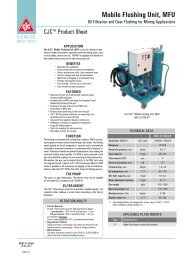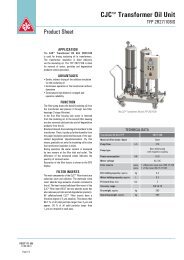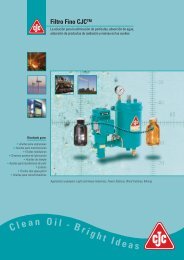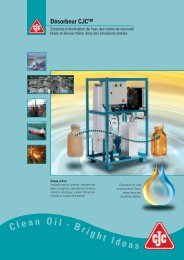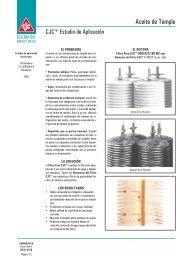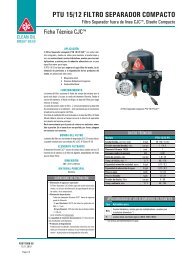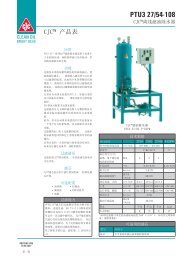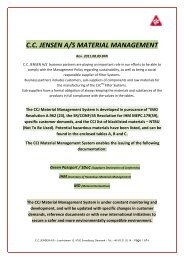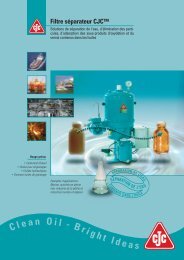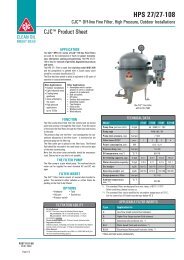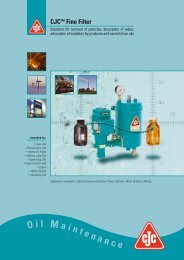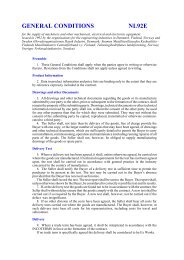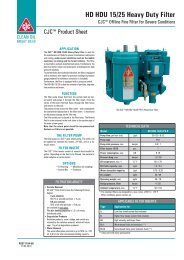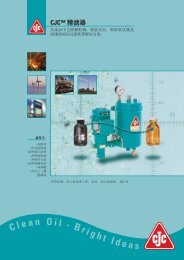Oil Degradation (Varnish) - Cjc.dk
Oil Degradation (Varnish) - Cjc.dk
Oil Degradation (Varnish) - Cjc.dk
Create successful ePaper yourself
Turn your PDF publications into a flip-book with our unique Google optimized e-Paper software.
Methods to Monitor<br />
<strong>Oil</strong> <strong>Degradation</strong><br />
Methods to Monitor the Level of <strong>Degradation</strong> in the <strong>Oil</strong>:<br />
Ultracentrifuge<br />
test<br />
Colourimetric/<br />
millipore<br />
membrane<br />
analysis<br />
Ultracentrifuge Test:<br />
This test uses the gravitatory forces<br />
to extract and settle the contaminants<br />
of the oil. The sediments<br />
are compared with a sedimentation<br />
rating system to determine<br />
the degradation of the oil.<br />
Colourimetric/Millipore<br />
Membrane Analysis:<br />
This analysis is an indication that<br />
the oil contains degradation products.<br />
The varnish is captured in<br />
the white millipore membrane<br />
(0.45 micron cellulose membrane),<br />
and shows as a yellow, brownish<br />
or dark colour depending on the<br />
amount of varnish present in the<br />
oil. A microscopic magnification<br />
shows if the colour comes from<br />
varnish or hard particles.<br />
Infrared Spectroscopy:<br />
(FTIR Analysis - Fourier Transformation<br />
Infrared Spectroscopy)<br />
This analysis is based on the principles<br />
of molecular spectroscopy. It<br />
can verify the level of oil degradation<br />
by the identification of the<br />
functional groups (e.g. ketones,<br />
carboxylic acids) in molecules.<br />
QSA Test:<br />
This method identifies the varnish<br />
potential rating, and is based on<br />
colorimetric analysis.<br />
By comparing the result to a large<br />
database of QSA tests, a 1 to 100<br />
severity rating scale indicates the<br />
propensity of the lubricant to form<br />
sludge and varnish<br />
Infrared<br />
spectroscopy<br />
QSA<br />
test<br />
Gravimetric<br />
analysis<br />
Gravimetric Analysis:<br />
This analysis can determine the<br />
level of oil degradation by measuring<br />
the weight of residual<br />
components.<br />
Viscosity Test:<br />
This test measures the oil resistance<br />
to flow. It can be used as an<br />
indicator of oil degradation.<br />
Viscosity<br />
test<br />
RULER<br />
test<br />
RULER Test<br />
Indicates the amount of anti-oxidants<br />
(oil additives). When the additives<br />
get depleted due to incipient<br />
degradation of the oil the RULER<br />
number decreases. This effect is<br />
evident before varnish starts precipitating,<br />
which makes the test<br />
proactive.<br />
TAN (Total Acid Number):<br />
This analysis measures the level of<br />
acid compounds. It can also be<br />
used as an indicator of oil degradation,<br />
since acid is a product of<br />
degradation.<br />
TAN<br />
analysis<br />
Methods to Monitor the Consumption of Additives:<br />
FTIR Analysis<br />
(Fourier Transformation Infrared Spectroscopy)<br />
It can monitor the additive depletion.<br />
RULER Test (Remaining Useful Life Evaluation Routine)<br />
It measures the remaining antioxidants by voltammetric analysis.<br />
RBOT Test (Rotating Bomb Oxidation Test)<br />
It measures the oil’s resistence to oxidation under prescribed conditions.<br />
11



